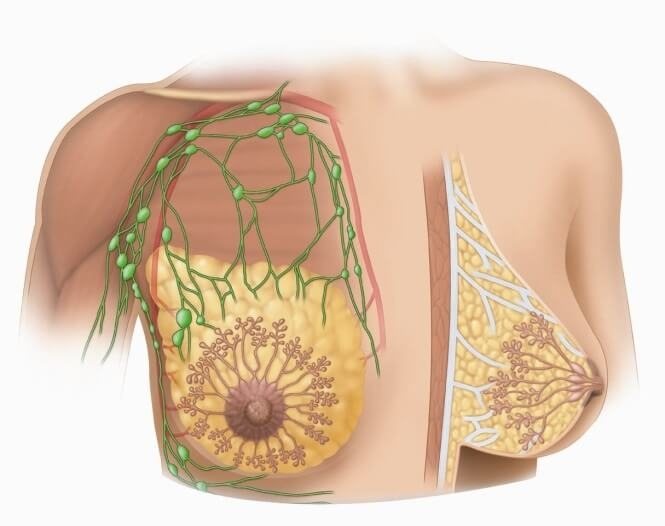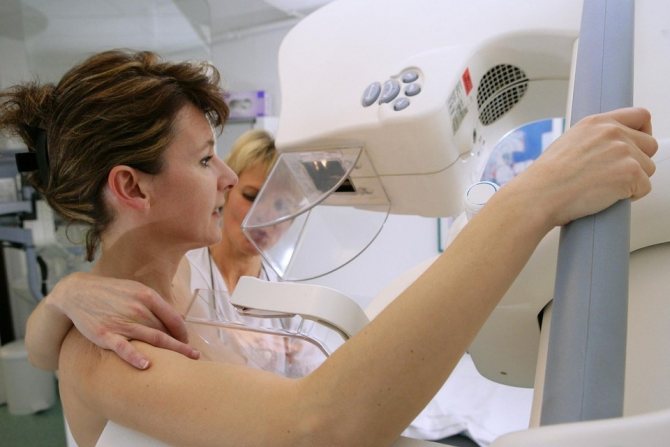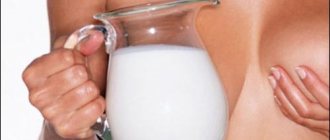Involution from Latin means “coagulation”; in physiological terms, it is the reverse development of something. In our case, this is curtailment, the completion of lactation in the most natural way: without the targeted help and desire of the mother, without tricks and tricks. Termination of lactation is its logical conclusion, when the baby himself is ready to give up the breast as unnecessary. These two points often coincide.
The child acquires all the necessary enzymes to digest adult food, he learns about the world, plays a lot and may well forget to eat breast milk, which, in response to this, gradually fades away.
Signs of lactation involution
Many mothers are concerned about the question of how asymptomatic the process of natural completion of breastfeeding is?
During involution of lactation, a woman does not experience pain and fullness in the chest, as with artificial weaning. Milk does not accumulate in the breast, it does not stagnate in the mammary glands, and there is no threat of developing mastitis.
This is due to the fact that the production of the hormone prolactin, which is responsible for lactation, gradually decreases in a woman’s body. In response to this, less and less milk is produced: by the time of involution there is so little of it that the breasts do not even swell between feedings with a break of 12-24 hours.
This is the most important sign of lactation involution - the breasts constantly remain soft, even just before feeding.
When is it time to stop breastfeeding?
Yulia Bondar
10 minutes
1135
There are a great many opinions on this matter: the time when it is time to wean a child from the breast varies from several months to infinity from the point of view of supporters of self-weaning. But this issue has always been considered from the point of view of benefit for the baby. What does medicine say about what timing of involution will be useful not for the child, but for the woman?
What is lactation involution?
Involution of lactation (from Latin involutio - coagulation) is a physiological process that ends the period of breastfeeding. This biological mechanism starts 40 days after the baby was last put to the breast. From the moment involution begins, the mammary glands decrease in size and stop producing breast milk. Typically, the involution process is recommended to be carried out gradually so that the child can adapt to the new way of receiving food, and also learns to calm down without attaching to the mother's breast.
Under normal conditions, lactation will continue in each mammary gland until milk is removed from it - and this phenomenon, the same for animals and humans, is used in agriculture. As the volume of milk production decreases, its composition changes: the content of fat and immunoglobulins increases, and the level of lactose decreases. If lactation is not stopped forcibly, it can continue until the child self-weans; under natural conditions this usually occurs at 2 - 2.5 years.
The process starts when the pituitary gland stops producing enough of the hormone prolactin. Milk production continues for some time after suction has stopped. As they write in WHO materials, “if in most mammals “drying out” occurs on the 5th day after the last feeding, then the period of involution in women lasts on average 40 days. During this period, it is relatively easy to restore full lactation if the baby resumes frequent sucking.”
Thus, as soon as breastfeeding becomes rare and short-lived, the process of involution begins. This can happen at any time - it is known that sometimes children themselves refuse breastfeeding for a variety of reasons, which need to be discussed separately. Protein synthesis is inhibited and structural changes in the mammary gland occur - the reverse replacement of glandular tissue with adipose tissue begins, which allows the breasts to return to their previous size and shape.
Signs of lactation involution
If involution occurs naturally, it usually begins when the child is two years old. At this time, the frequency of attachments naturally decreases: the child develops other interests, including an interest in “adult” food. How can a nursing mother understand that involution has begun?
The breasts slightly decrease in size and do not fill with milk, even if you do not feed for more than 12-24 hours. That is why if at this time the baby stops sucking the breast, this does not cause the mother any distress or suffering from excess milk. Milk, in composition, properties and appearance, increasingly resembles colostrum.
The baby's sucking activity increases noticeably. This happens because milk production decreases, and the baby still tries to suck the same amount of milk. During one feeding, a baby can be applied to one breast, then to the other - and so on several times. The period of such sucking activity can last up to several months.
Psychological readiness of the mother for weaning. This is a very important sign that should not be ignored. As soon as a nursing mother feels tired from breastfeeding, this is a sign that the process is either incorrectly regulated or, if there have been no problems with lactation so far, is coming to an end.
Psychological readiness of the child for weaning. Typically, by the age of two, the child has socialized, ceases to have an urgent need for tactile contact with the mother, and begins to receive the necessary nutrients from other sources. The child gradually loses psychological need
Forced involution
If there is a need to wean your baby ahead of schedule, then you need to be prepared for the following consequences:
- pain and discomfort in the mammary glands of varying degrees of intensity;
- formation of compactions in the mammary glands;
- increased body temperature;
- deterioration of general condition;
- purulent-inflammatory complications (breast abscess and mastitis).
If the need to interrupt lactation is related to medical indications, then involution must be carried out under the supervision of a doctor. What should you do first? Reduce the number of feedings by offering the baby a different food source. In addition, strict control over fluid intake and its limitation is necessary, and additional pumping may be required in order to avoid stagnation of milk.
If you feel tired from breastfeeding
The psychological state of a nursing mother is a very important criterion that needs to be paid close attention to. Lactation is a very energy- and resource-intensive project for the female body, and it is not surprising that sooner or later exhaustion occurs. Some breastfeeding mothers can wait for natural involution without any problems, but for many there comes a time when, due to fatigue, continuing to feed is impossible. Unfortunately, this objective situation (the amount of strength and resources is strictly individual) often causes a feeling of guilt in a nursing mother, since advertising of the need for breastfeeding before self-weaning has reached its maximum in recent years. What needs to be assessed at this moment? On one side of the scale is the benefit for the child, and on the other is the psychological and physical comfort of the mother.
Many in such a situation will choose the comfort of the mother, and they will be right. How long breastfeeding will continue is up to her to decide, since only she can assess the degree of her exhaustion. After all, there are now excellent breast milk substitutes, and a calm and rested mother is an irreplaceable resource that cannot be replaced by anything.
Many experts say that breastfeeding until one and a half years of age may be optimal. Thus, the famous pediatrician Dr. Komarovsky recommends starting to correct breastfeeding starting from the age of one year: at this age it is time to introduce calming rituals that replace breastfeeding, and also gradually reduce the number of daily feedings. WHO recommendations to breastfeed children for more than two years, according to Komarovsky, are due to high infant mortality rates in Asia and Africa, where the life of a child often directly depends on how long his mother breastfeeds. As soon as breastfeeding ends in countries with an objective shortage of water and with a high prevalence of intestinal infections, the child's life is at risk, so long-term breastfeeding in such countries saves children's lives.
For European countries, the situation with high infant mortality is not relevant. Therefore, in our realities, it is necessary to make a decision on involution of breastfeeding based on the needs of the child and the condition of the mother.
Symptoms accompanying cessation of breastfeeding
Although, in comparison with artificial weaning, lactation involution is the most comfortable, safe and natural process, the mother may still experience some unpleasant conditions:
- general weakness, fatigue, irritability; - dizziness after breastfeeding; - discomfort in the chest during feeding; - disruption of the menstrual cycle for several months.
You can also observe the baby's restless behavior during feeding: he will not be able to concentrate on breastfeeding, since there is little milk, and will involuntarily express concern about this.
On “mother’s” forums you can often see the phrase “I have started involution.” When checked, it turns out that not all nursing mothers know what it really is and most often associate this term with poor health, frequent colds and crumbling teeth.
In fact, the involution of lactation has nothing to do with colds or teeth. So let's try to figure out what it really is and what to do if involution has actually begun for you.
In the medical literature there are two terms “involution”: mammary gland and lactation.
In the first case, these are processes of change in the woman’s mammary gland after the end of feeding. At this time, the breasts undergo a reverse process to their pre-pregnancy state: the cells that produced milk are destroyed, the ducts in the nipples close. This process takes about 40 days and is the same for all women, regardless of the “experience” of feeding.
In this case, we are interested in the second type of term – involution of lactation. This process can only be experienced by those mothers who managed to organize breastfeeding “naturally”, that is, they fed the baby on demand and did not give him pacifiers and bottles. In addition, involution will not occur until your baby is one year and three months old, and most likely the waiting process will last up to two years. Most often, at this time, the baby requires mother’s milk not as the main food (children of one and a half to two years old, as a rule, already eat more “adult” food), but as a way to maintain immunity. Therefore, milk at this time is not saturated with proteins and carbohydrates, but with immune factors, which are so important for the development of the child’s nervous system and brain. Milk during the involution period is very similar in composition to colostrum, rich in immunoglobulins. This composition will help give your baby a boost of immunity for a long time, even if you decide to stop breastfeeding immediately after the period of involution.
How to recognize involution? This process has very clear signs: The baby asks for the breast more often (the number of attachments can remain at 8-12 per day)
- the baby asks for the breast more often (the number of latches can be kept at 8-12 per day);
- despite the fact that the baby is actively suckling, the amount of milk decreases sharply, and the breast does not have time to fill even in 12-24 hours (that is, even if the baby has not been put to the breast for a day, you do not feel the desire to express urgently);
- the mother experiences a condition similar to the first weeks of pregnancy: drowsiness, fatigue, sudden mood swings, irritability, sometimes even nausea;
- nipple sensitivity may increase;
- Many women experience irregularities in their menstrual cycle.
Remember that the involution process does not take long. Most often it is 1-2 months. If poor health does not go away longer, you should simply reconsider your lifestyle, nutrition, and physical activity. After all, most likely your ailments have nothing to do with involution. In addition, involution does not affect the condition of the skin, hair and teeth. It has been proven that during this period the process of calcium absorption in the mother’s body accelerates and with proper nutrition and a healthy lifestyle, your teeth and bones are not in danger.
And also, when deciding on early weaning, remember that stopping breastfeeding after involution is unnoticed and painless for both mother and child. The child, having received everything he needs from mother’s milk, calmly forgets about it, completely switching to “adult” food. The mother does not need to bandage her breasts or take medications to stop lactation (the milk will disappear on its own after the baby latches onto the breast for the last time). You are not threatened with stagnation and mastitis. In addition, prolonged breastfeeding has a positive effect on the mother’s health, helping to restore her figure naturally (without dieting or heavy physical activity) and protecting her from such a serious disease as breast cancer.
So think about it, maybe it’s not worth weaning your baby just yet? After all, for both of you this is an unforgettable period of intimacy that will never happen again!
Similar articles:
Umbilical hernia in newborns: symptoms and prevention (9595 Views) Newborn > Childhood diseases
One of the common diseases of newborns is an umbilical hernia. Hernias of different sizes are observed: starting from a pea and ending with a large pear. The muscles of the baby’s anterior abdominal wall are still weak...
Hydrocephalus in children. Its nature, causes and varieties (5472 Views) Newborn > Health
First of all, it is worth answering the question, what is hydrocephalus? The term itself comes from the ancient Greek words “hydro” - water and “cephalus” - head and means excess accumulation of fluid in the tissues of the brain...
Let me introduce your faithful assistant - Her Majesty, Fairy Tale! () Preschool children > Raising a child
Since the 1990s, a new technique has emerged in Russia to help parents raise children. It immediately attracted the attention of many people, as it was easy to use and did not require special training.
Allergy and its roots (3679 Views) Pregnancy and childbirth > Pregnant health
Preventing the occurrence of any disease is better than treating it - everyone will agree with this. Such diseases include allergies, which manifest themselves in the form of rhinitis, urticaria, or much worse -…
Varicose veins: symptoms and causes (4253 Views) Pregnancy and childbirth > Pregnant health
Pregnancy in many respects requires special attention to the woman’s health. And one of the reasons is that pregnancy creates favorable conditions for the development of diseases such as varicose veins...
What it is
What is fibrofatty involution of the mammary glands? This is a complex transformation, as a result of which the glandular tissue of the breast is gradually replaced by fatty or fibrous tissue. It is involution that influences the changes in the mammary glands during the postmenopausal period.
If changes began during menopause, then there is no reason to worry, since this is not a disease, but a natural reaction of the body to the loss of reproductive function.
The same condition occurs at the end of lactation, when the breasts return to their original size. During pregnancy and lactation, glandular tissues and milk ducts actively grow due to increased levels of prolactin and other hormones, and the bust noticeably increases in size. After breastfeeding is completed, the hormonal levels stabilize and breast involution occurs, or, more simply, reverse development.

Symptoms of breast involution
The natural process of involution of the mammary glands, as a rule, occurs without pathologies. Slight swelling and mild soreness that do not cause discomfort are allowed.
The process of changes in the breast is clearly visible on x-rays. The changed areas will be lighter, and the vessels will be clearly visualized. A large amount of adipose tissue leads to the fact that the breasts begin to lose their elasticity. The function of the breast frame is performed by the glandular tissues; in their absence, the breasts begin to change - they sag, and the skin becomes thinner, becomes wrinkled and wrinkled.
During this period, symptoms of mastodonia may appear:
- feeling of hardening of the mammary glands
- increased breast sensitivity when touched
- muscle tension
Even if no pathological signs are observed, periodic observations by a mammologist are necessary. They will help detect the disease in time. The most common pathology is the formation of cysts, papillomas, and tumors. Cystic formations in the chest area are in the form of balls with fluid.

Diagnostics
Signs of fibrofatty involution of the mammary glands in the initial stage are practically invisible and it is diagnosed, as a rule, by chance, during a routine examination, during an ultrasound or mammography.
The main method for diagnosing breast diseases is mammography; fibrofatty involution and some other pathologies are recognized on ultrasound only in the last stages of development. A blood test for hormones can also help diagnose some diseases.
Every woman should know that from the first signs of menopause it is necessary to have an annual mammogram and be examined by a mammologist. After 50 years, you need to visit a mammologist twice a year. Regular examinations will help to timely diagnose various pathologies, such as fibrofatty mastopathy, fibroadenoma and other neoplasms. Detection of pathological processes in the early stages significantly increases the chances of cure.












